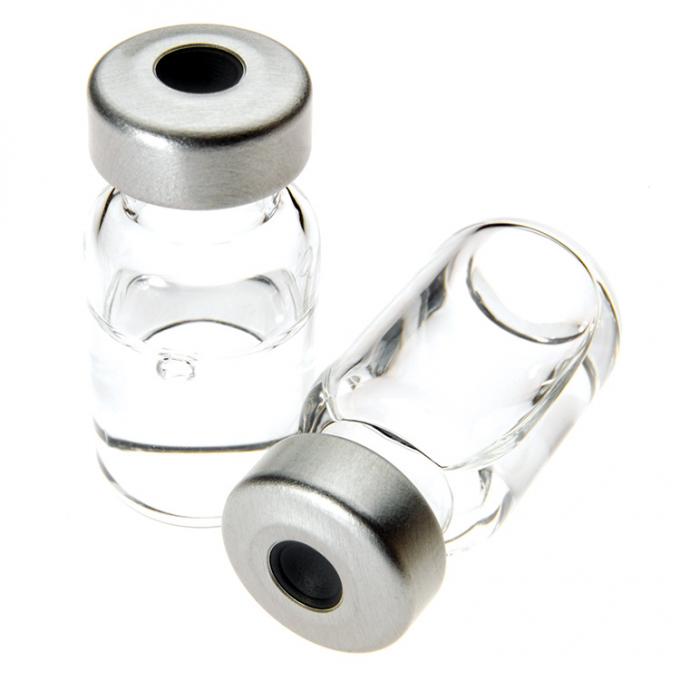

The U.S. Food and Drug Administration (FDA) has lifted its clinical hold on the investigational long-acting medication lenacapavir, being developed for both treatment and prevention of HIV. The agency had halted development back in December 2021 due to issues with the borosilicate glass vials being used in research trials. On May 16, Gilead Sciences announced that the hold had been lifted “following the agency’s review of Gilead’s comprehensive plan and corresponding data on the storage and compatibility of lenacapavir injection with an alternative vial made from aluminosilicate glass.”
During the hold, research with the oral long-lasting formulation had continued. Enrollment for the injectable doses of the studies can now be re-started. In May 2019, lenacapavir received FDA Breakthrough Therapy Designation for development of HIV in heavily treatment-experienced patients with multi-drug resistance in combination with other antiviral drugs. It is the first of a new class of drugs, HIV capsid inhibitors.
Despite vaccination, breakthrough COVID-19 occurs more often in HIV
Among people vaccinated against COVID-19, individuals living with HIV had a higher rate of contracting the disease (known as “breakthrough infection”) than people who were HIV-negative.
The finding came from a research team at Johns Hopkins University Bloomberg School of Public Health. Although their study found a low rate of COVID-19 infections for both positive and negative people, it was still 28% higher for those with HIV. The difference was 3.8% breakthrough COVID infections for the non-HIV group vs. 4.4% for the people living with HIV. Both rates are much lower than is seen with unvaccinated people.
The study looked at health records of almost 114,000 fully vaccinated individuals, of whom 33,000 were positive. It was published June 7 in JAMA Network Open.
The research team noted that the recommendation from the U.S. Centers for Disease Control and Prevention (CDC) is for people who are “moderately or severely immunocompromised” to receive an extra dose of vaccine as part of their primary vaccination series, followed by a booster. This category includes people living with HIV who are not receiving antiviral medication or who have less than 200 T cells.
HIV and Long COVID
The recently created Network for Long COVID Justice brings together the HIV and other chronic illness communities to advocate for information and resources as well as provide mutual support. In May, the network released a comprehensive report, Resourcing the HIV Community to Face COVID and Long COVID in 2022, that covers much of its work at the intersection of HIV and Long COVID, with embedded videos online: bit.ly/HIVreport.
According to the report, “Increasing evidence indicates that PLHIV [people living with HIV] may be at significantly higher risk of Long COVID, an umbrella term for a range of potentially severe, chronic conditions in people following a COVID-19 infection, including those that initially manifest as asymptomatic or mild cases.” It discusses post-exertional malaise (PEM), the worsening of symptoms after mental, physical, or emotional exertion. HIV activists and medical providers discuss strategies and study findings. There is also a list of support groups.
Watch a short video of Phillip Shubin telling his compelling story of contracting HIV and COVID-19 early in both epidemics and the dramatic effects on his mental and physical health: bit.ly/strategies4highimpact. Check out the network at their website home, springboardhealthlab.org/long-covid-justice.
FAQs for injectable PrEP
NASTAD (the National Alliance of State and Territorial AIDS Directors) in May added an FAQ (frequently asked questions) document on injectable PrEP (pre-exposure prophylaxis, or prevention) to its website. The document includes insurance coverage information and is part of NASTAD’s PrEP “microsite.” Apretude is the first, and still the only, injectable PrEP approved by the U.S. Food and Drug Administration (FDA). Go to nastad.org/long-acting-injectable-prep; the microsite is at nastad.org/prep-access.
Telehealth and PrEP
The Kaiser Family Foundation has issued a report on the use of telehealth in PrEP, with funding from Southern California HIV/AIDS Policy Research Centers (SCHPRC). “Even before the COVID-19 pandemic, HIV pre-exposure prophylaxis (PrEP) became more accessible outside of traditional clinical settings through websites, apps, and other programs that offer PrEP via telehealth,” SCHPRC noted upon the report’s release in May. “The use of telehealth to provide PrEP (“telePrEP”) has the potential to address longstanding disparities in PrEP use, but little is known about the current telePrEP environment.” Go to chprc.org/prep-access-in-the-united-states-the-role-of-telehealth.
Patients illegally billed for PrEP
PrEP medication for the prevention of HIV is now free, including associated lab work, but some insurance companies are still charging patients for various costs. Read the April report by Larry Buhl at TheBody.com at thebody.com/article/insurers-illegally-charging-prep?ic=700100&mcid=2940f9d348&vhid=.
“There’s evidence showing that the problem of overcharging [for PrEP] is huge and widespread,” says Kenyon Farrow, managing director of advocacy and organizing at PrEP4All, in the report. Bills have totalled in the hundreds of dollars.
Abortion rights and trans people
“Transgender people get pregnant. And sometimes trans people need abortions,” writes Imara Jones, founder of TransLash Media, and Kierra Johnson, executive director of the National LGBTQ Task Force. Their short but powerful commentary at LGBTQ Nation online addresses many aspects of the harms of both the anti-abortion movement, including the assault on body autonomy, and the abortion rights movement. “As is often the case, the forces opposed to body autonomy for cisgender women also oppose it for trans people,” they write. “It is clear that this is one fight, but for decades, there has been an over-emphasis on cisgender women in the reproductive rights movement and transgender people have been left out and left behind.” The online piece includes two short films from TransLash’s “Trans Bodies, Trans choices” series, including “My Abortion Saved My Life.” Go to lgbtqnation.com/2022/03/transgender-people-get-pregnant-sometimes-trans-people-need-abortion. Subscribe to TransLash at TransLash.org.
Me in You, You in Me anti-stigma campaign
ViiV Healthcare announced a new anti-stigma campaign “aimed at increasing conversations around HIV prevention and addressing the stigma that can stand in the way of action.” Me in You, You in Me “reflects ViiV’s belief that if we can put an end to stigma, we can put an end to HIV.”
“Recognizing that the communities most disproportionately affected by HIV are those who have benefited the least from the advances in HIV prevention, the campaign seeks to ensure that all people are aware of the role they can play in preventing HIV and to connect them to resources,” the HIV pharmaceutical company reported.
In addition to providing videos, the campaign directs people to HIV services at locator.hiv.gov. Special activities are scheduled for Atlanta, Chicago, Dallas, and Miami/Ft. Lauderdale. Go to the campaign and other cultural initiatives at viivhealthcare.com/en-us/ending-hiv/viivs-initiative.
Pediatric hepatitis of unknown origin
The U.S. Centers for Disease Control and Prevention (CDC) reported on May 6 that it is working with health departments across the country to identify pediatric cases of hepatitis of unknown origin.
A hospital in Alabama had five such cases in October 2021. Four additional pediatric cases were found after a review of hospital records. Liver illness was severe and a liver transplant was necessary in some instances. None of the children had evidence of hepatitis A, B, C, D, or E or of SARS-CoV-2 (the virus that causes COVID-19), but some tested positive for adenovirus, which causes cold- or flu-like illness. In particular, they tested positive for adenovirus type 41, which is more likely to cause severe stomach illness in children. Symptoms include fever, diarrhea, vomiting, and abdominal pain. Respiratory symptoms may also occur.
The children ranged in age from one to six years old and were previously healthy, with no significant underlying medical conditions. They were from different parts of the state and had no common exposure. As of the date of the report, they were all recovering.
CDC asked parents to keep children up-to-date on vaccinations and to be aware of signs of liver inflammation:
- fever
- fatigue
- loss of appetite
- nausea
- vomiting
- abdominal pain
- dark urine
- light-colored stools (poop)
- joint pain
- jaundice (yellowing of the skin)
Parents should also help children with regular disease-prevention practices, particularly washing hands often; avoiding people who are sick; covering coughs and sneezes; and teaching them to avoid touching the eyes, nose, or mouth.
Read the CDC’s report to the public at cdc.gov/ncird/investigation/hepatitis-unknown-cause/overview-what-to-know.html.
Native American HIV and hepatitis efforts get federal funding
The Indian Health Service (IHS) in April announced a funding opportunity for its new Ending the HIV and Hepatitis C Virus (HCV) Epidemics in Indian Country (ETHIC) program. ETHIC is part of IHS work in the Ending the HIV Epidemic in the U.S. (EHE) initiative. Hear IHS National HIV/HCV Consultant Rick Haverkate speak briefly to the funding for community expertise from Indian tribes and urban Indian health organizations at bit.ly/endHIVinIndianCountry. In a press release, IHS reported that, “Among people living with HIV, American Indians and Alaska Natives have the largest percentage of persons with undiagnosed HIV infection.”
Ending hepatitis is something we can all do every day
That’s the title of a short blog for Hepatitis Awareness Month in May and for Hepatitis Awareness Day (May 19) by Carl Schmid, executive director of the HIV+Hepatitis Policy Institute and a member of the Presidential Advisory Council on HIV/AIDS (PACHA). Schmid points to the need for prevention, testing, and treating, all in the face of continuing stigma and discrimination. He notes that there are vaccines to prevent hepatitis A and B and an outright cure for hepatitis C.
“You have heard it said before, ‘We have the tools to end it.’ I would add the saying, ‘Easier said than done.’ To end infectious diseases, we always need more scientific advances, but it is going to take a strategic, coordinated, and resourced public health response,” writes Schmid.
Go to hiv.gov/blog/ending-hepatitis-something-we-can-all-do-every-day.
The following blog post, reprinted here in its entirety, addresses several issues related to the syphilis epidemic, including the effect on newborns in the U.S. and the need for HIV PrEP. It was written by Leandro Mena, MD, MPH, director of the Division of STD Prevention, National Center for HIV, Viral Hepatitis, STD, and TB Prevention and published April 13. Go to the CDC surveillance report at cdc.gov/std/statistics/2020.

Leandro Mena, MD, MPH
“Syphilis continues to disproportionately affect gay, bisexual and other men who have sex with men (MSM), but a decades-long increase in reported cases may be reversing, according to Sexually Transmitted Disease (STD) Surveillance, 2020. The CDC annual report was published this week during STD Awareness Week 2022.
“This apparent leveling-off in reported primary and secondary (P&S) syphilis cases among gay and bisexual men is a small glimmer of hope in an otherwise concerning report. The data collected in 2020 for this report show that even in the first year of the COVID-19 pandemic, 2.4 million cases of chlamydia, gonorrhea, and syphilis were reported in the United States.
“Nationally, the number of P&S (the most infectious stages of the disease) syphilis cases among MSM slightly declined—2.2 percent—during 2019-2020. However, this population remains disproportionately affected—comprising 43 percent of all P&S cases.
“Tried and true prevention strategies work against this very preventable infection.
“For anyone who gets syphilis, diagnosis and timely treatment are essential. CDC recommends that all MSM be tested at least annually for syphilis. Some may need to be tested more frequently, including those with multiple sex partners. Syphilis can be cured with the right antibiotics. If not treated, syphilis can cause serious health problems, including neurologic (brain and nerve) problems, eye problems, and even blindness.
“While syphilis can increase the risk of HIV transmission, a syphilis diagnosis can also open the door to HIV prevention, including pre-exposure prophylaxis (or PrEP). STD surveillance data show us that the HIV prevention opportunity here is great—in 2020, over 8,400 MSM diagnosed with P&S syphilis were HIV-negative and an additional 2,300 had unknown HIV status. Each person diagnosed with syphilis represents an HIV prevention opportunity. And for those who are living with HIV and are diagnosed with syphilis, their syphilis diagnosis can be a critical HIV care touchpoint.
“Ending the HIV Epidemic in the U.S. (EHE) has provided a pathway to address this overlap. As part of EHE, CDC is investing in resources to scale up quality HIV prevention services in STD clinics. By addressing syphilis and other STIs alongside HIV, we are tackling this problematic syndemic, or interconnected epidemics.
“We have a long way to go. Despite the small national decline in reported cases of P&S syphilis among MSM, some states still reported increases among MSM in 2020. Simultaneously, preliminary 2021 data show that reported P&S syphilis continues to increase in the United States, particularly among women, which is resulting in sobering increases in syphilis among newborns.
“Amidst these challenges, the first-ever STI National Strategic Plan is providing much-needed direction in addressing not only syphilis, but other STIs and related infections. The Plan includes a call to address the syndemics of not only STIs and HIV, but also of viral hepatitis and substance use disorders. It challenges federal and nonfederal stakeholders at all levels and sectors to collaborate on a whole-of-nation, whole-person response, going beyond a diagnosis of disease to address the health and well-being of every person in the nation. It’s a tall order, but we can do it.
“We are encouraged with even small signs of progress among this population disproportionately affected by STIs. I believe we can build on this momentum to meet the goals of decreasing the dramatic toll of STIs.”
The U.S. Centers for Disease Control and Prevention (CDC) in April issued a new—first-time—quick reference document addressing its recommendations for the testing, vaccination, and treatment of HIV, tuberculosis (TB), viral hepatitis, and sexually transmitted infections (STIs) for people who are detained or incarcerated. The quick guide does not include all the CDC recommendations for people who are incarcerated. The agency noted that it recognizes that a facility’s ability to follow the recommendations depends on such things as funding, capacity, and population turnover.
In a letter to healthcare professionals, Jonathan H. Mermin, MD, MPH, and Donna Hubbard, PhD, MPH, RPh, of the CDC noted that the rate of the following conditions are more common among people who are detained or incarcerated compared to the country’s population at large:
- HIV is 3 times higher in state and federal prisons
- Hepatitis C is 10 times higher in jails and prisons
- TB is 6 times higher in jails and federal prisons
- Rates of STIs, chlamydia, and gonorrhea are higher among people aged 35 years and younger in juvenile and adult detention facilities
In addition, about 4% of women entering prisons or jails are pregnant, and recommendations address their needs as well.
At entry:
- Everyone should be screened for hepatitis B and hepatitis C, and for symptoms of pulmonary TB
- Testing for HIV and syphilis depends on prevalence of undiagnosed infections of these conditions in the facility, as well as local prevalence for syphilis
- All women ages 35 and younger and all men ages 30 and under should be screened for gonorrhea and chlamydia
- All women ages 35 and younger should be screened for trichomonas
- There are different recommendations during stays, depending on such factors as ongoing susceptibility (basically, exposure)
Screening should be opt-out, meaning that testing will be done unless a person specifically refuses the test (probably through paperwork that needs to be filled out).
Testing recommendations for pregnant persons follow the same guidelines as for the general population: HIV (with repeat testing as warranted), hepatitis B and C, and syphilis. Testing for chlamydia and gonorrhea should be done for all pregnant persons under age 25 and for those 25 and older who have increased vulnerability for these infections.
Vaccines:
- Everyone ages 18 and younger should be vaccinated with the series of shots against hepatitis A
- All adults at risk for hepatitis A (including men who have sex with men; people who inject drugs; and persons experiencing homelessness) should be vaccinated against hepatitis A
- All juveniles and adults should be vaccinated with the series of shots for hepatitis B
- HPV (human papillomavirus) shots can be started at age 9, with routine vaccination beginning around age 11; catch-up vaccination for all individuals who are not adequately vaccinated is recommended for people up to age 26
Treatment recommendations follow various medical guidelines for the particular condition.
At the time of release, people living with HIV should be given an adequate supply of antiviral medication to bridge the gap until they can enter into healthcare. HIV-negative individuals with known HIV risk factors should be told about PrEP (pre-exposure prophylaxis). Prevention counseling for both groups should include information on risk reduction and condom use.
“Correctional health is community health,” wrote Mermin and Hubbard. “Together, we can improve the health of people who are incarcerated or detained, their families and the communities to which most people return by testing and treating HIV, viral hepatitis, STIs, and TB while people are incarcerated or detained.”
Go to the new document at cdc.gov/correctionalhealth/rec-guide.html. Also see education material at cdc.gov/correctionalhealth/health-ed.html.


